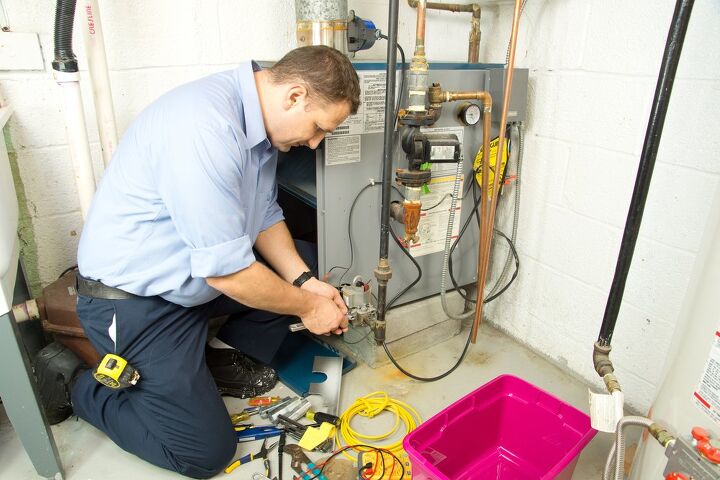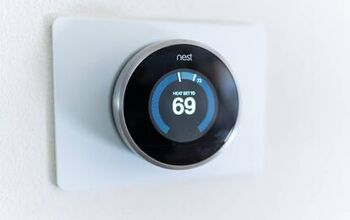How Long Does A Furnace Last? (Plus Signs of Failure)

If your heater was there when you bought your home and you have been there for 15 years, you should probably be shopping around for a new one. In fact, most experts recommend that you start looking for good deals when your furnace turns 15 anyway.
The average lifespan of an older-type furnace may be less than 15 years, but they typically go for at least 15. However, the newer ones can last from 15 to 30 years. This depends on the brand, type, usage, and maintenance. The answer typically also relies on the type of furnace though. There are gas, electric, oil, and propane.
If the furnace you have now has been cranking out heat for the past 20 to 30 years, you must have a good brand, so you may want to stick to it. Otherwise, you will want to shop around and find out the best models for furnaces. Some of the top brands include Carrier, Rheem, Goodman, Trane, and American Standard.
Do You Need Gas Furnace or Forced Air Heating System Installers?
Get free, zero-commitment quotes from pro contractors near you.

How Long Does a Gas Furnace Last?
The natural gas furnace is the most popular type of furnace in the United States. They are also the most efficient with a rating of 65% to 98% in most cases. Although they do tend to cost more, gas furnaces are worth it with such a high-efficiency rating, long lifespan, and least monthly cost to run.
A quality gas furnace will last about 25 years with proper maintenance. This means changing the furnace filter often, getting the furnace inspected twice a year, and always getting it checked if there is a strange noise, smell, or lack of heat. You also have to have proper ventilation and make sure there is no moisture in and around the furnace.
How Long Does an Electric Furnace Last?
An electric furnace is the least expensive to purchase and can last up to 10 years longer than a gas furnace. A good electric furnace will last you about 30 years or more. Installing an electric furnace can be less than half the cost of installing a gas furnace.
But the cost to use the electric furnace is a lot higher. Where a gas furnace may cost you $100 to $150 a month during the winter, an electric furnace can run up to $500 a month or more. Electric furnaces are quieter than gas furnaces though and you do not have to worry about carbon monoxide poisoning with electricity.
How Long Does an Oil Furnace Last?
The oil furnace is cheaper than gas but is not as efficient, only rating at about 80% efficiency. The life of an oil furnace is typically about 15 to 20 years, so they are on the average end of that spectrum. They are not as expensive to run and will keep your home warm all winter, but there are some drawbacks to the oil furnace.
For example, an oil furnace requires you to have an oil tank to be installed under your home, which can be expensive. Not only that, but you will have to inspect it often to make sure it is not leaking because that would be dangerous. You will also need to keep the tank full and that requires a source to bring you oil as needed. And oil is always expensive. Just check your gas prices.
How Long Does a Propane Furnace Last?
The propane furnace is small, fitting in crawlspaces or attics, and propane is the most eco-friendly fuel available with an 80% efficiency rating. The life span of a propane furnace is about 20 to 30 years so it will last you a good long time. About 10 million households in the United States use propane to heat their homes. Propane is stored in a propane tank outside your house and is usually found in rural areas where there are no oil or gas furnace options.
The cost to refill the tank varies from $400 to $3,000 depending on the size of your tank. But you may only need to use one tank per year, so that is $400 for the whole year. But some people do not like having that large expense once a year. It is a safe, economical, and clean way to provide heating and other appliances in the house. And it is always available, even if the power or gas is out for some reason.
How Can You Tell if Your Heater is Going Out?
If your furnace is more than 15 years old, you should start shopping for a furnace even if it is still working well. The efficiency of an older furnace is only about 20% of its maximum efficiency. So, a gas furnace that is rated at 98% efficiency is only going to be about 25% efficient after 15 years.
But there are some signs to look for that your furnace may be trying to tell you something. You have to pay attention to those little hints your furnace is sending you. And you can have it serviced but the rule is usually 50/50. If it costs you more than 50% of the cost of a new one to fix, you may as well get a new one. Especially if it is over 15 years old.
Energy Bills Are Going Up
You may not even notice that your heater is kicking on more than usual until you get your heat bill. If your bill is suddenly much more expensive than normal, you may need to get it checked out.
Are You Having to Turn Up the Heat?
Are some rooms warmer than others? Is one of your rooms too warm while others are cold? These can be signs that there is something wrong because your furnace does not have the ability to distribute the warm air properly.
Is it Blowing Out Cold Air?
If your furnace is blowing cold air at any time, this is a sign that you need to call an HVAC expert. It could be any number of reasons like a blower fan or heating element, but no matter what it is, there is no reason for a furnace to blow out cold air.
Do You Hear Strange Noises from the Furnace?
Do you hear banging, knocking, rattling, humming, or squeaking noises coming from your furnace? Is the heater making a loud boom when it starts up? Any kind of new noise you are hearing from your furnace is a sign that something may be wrong. It may be your furnace’s last words.
The Burner Flame Color Changes
If you have a gas furnace, a yellow flame instead of a blue one may be a sign of carbon monoxide leaks. This is very important because carbon monoxide is deadly. Other signs of carbon monoxide issues include rust on the vent pipe, water leaking from the flue, vent, or chimney, rust on pipes or appliance jacks, and streaks of soot around the furnace. If you do not feel an upward draft going into your chimney, this can be another sign of a carbon monoxide leak.
The physical signs of carbon monoxide poisoning include flu-like symptoms, dizziness, disorientation, nausea, chest pain, burning eyes and nose, and frequent headaches. If you have a gas furnace and anyone in your home has these symptoms, leave the house right away and call the gas company.
Is the House Dusty or Dry?
Older furnaces do not have the ability to clean the air in your home and provide moisture as newer ones can. If it feels stuffy or you are suddenly suffering from what seems like allergies, you want to get your furnace checked out. Other signs include cracked furniture, drooping plants, static shocks, and dust accumulation.
Do You Need Gas Furnace or Forced Air Heating System Installers?
Get free, zero-commitment quotes from pro contractors near you.

Related Questions
How much does it cost to get a new furnace?
The cost of a furnace depends on many factors. Some of these include what type of furnace you want, what brand you are going with, and the area you live in.
| Type of Furnace | Cost of Furnace |
| Electric furnace | $1,500 to $5,500 |
| Gas furnace | $2,300 to $8,500 |
| Oil furnace | $4,200 to $7,000 |
| Propane furnace | $1,900 to $7,500 |
The five top furnace brands include:
- Carrier (offers all types)
- Rheem (offers all four types)
- Goodman (propane, electric, and gas)
- Trane (has gas and oil)
- American Standard (only has gas)
There are actually quite a few alternative heating sources. If you live in rural areas where gas lines are not as common, you will find that a lot of people depend on wood pellet stoves. Others use wood-burning stoves. Radiant heat is also a popular option in some situations. Those who are trying to save on energy may decide to use solar heating.
| Type of Heating | Description |
| Wood pellet stoves | A wood pellet stove is similar to a wood-burning stove, but they use small pellets rather than large pieces of wood. The pellets are sold in large bags of wood that is densely compressed pieces of wood. They burn cleaner than regular wood and can be good for small homes or just heating one room in the house. |
| Wood burning stoves | Wood burning stoves are just fireplaces with a heat vent that allows heat to be transferred to your house. Like wood pellet stoves, these are good for small homes or single rooms. |
| Radiant heat | Radiant heat is heat that is distributed through the floor and does not use heat vents at all. The heat comes up from the floor and heats your home with either solar, electricity, or oil radiators. |
| Solar heat (active) | Active solar heating uses the sun to heat liquid or air and then transfers it to your home or stores it for later. |
| Solar heat (passive) | Passive solar heat uses skylights or windows to provide heat in the home. It can be absorbed and stored in a thermal mass under the floor or in the walls. |

I am a DIYer who loves writing about anything home-related. When I am not writing, you can find me studying for my PhD in Psychology, photographing nature, and swimming at the lake with my grandkids.
More by Patricia Oelze



























